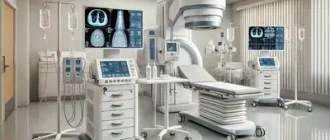Thyroid cancer is often referred to as the “silent threat.” But how exactly can artificial intelligence (AI) step in to make thyroid cancer detection more efficient and accurate? To answer this, let’s explore the latest developments in AI technology, why it matters, and how it’s reshaping patient outcomes.
Accuracy Comparison: AI-Assisted vs Traditional Diagnostic Methods for Thyroid Cancer
| Diagnostic Method | Accuracy Rate |
|---|---|
| Traditional Methods | 85% |
| AI-Assisted Methods | 94% |
This chart illustrates the accuracy comparison between AI-assisted and traditional diagnostic methods for thyroid cancer, highlighting the superior performance of AI technology.
Why is Early Detection of Thyroid Cancer so Challenging?
Early-stage thyroid cancer is notoriously difficult to detect. Unlike other types of cancer, it often presents no symptoms until it’s more advanced. In many cases, a lump or nodule on the neck is one of the first signs, and by then, treatment options can become more limited.
The issue lies in traditional detection methods. Ultrasound scans and biopsies are prone to human interpretation errors. In fact, according to a recent study by the American Thyroid Association, almost 15% of thyroid biopsies result in inconclusive findings. This creates an urgent need for more reliable diagnostic tools. Here is where AI steps in—reducing ambiguities, improving diagnostic accuracy, and ensuring earlier detection.
How Does AI Improve Thyroid Cancer Detection?
Artificial intelligence can analyze ultrasound images of the thyroid gland with a precision that goes beyond the capabilities of even the most experienced radiologists. Advanced machine learning models can differentiate between malignant and benign nodules with a high degree of accuracy—often over 90%. A recent study conducted at Stanford University found that AI-assisted diagnostic tools were able to identify malignant nodules with an accuracy of 94%, a substantial improvement over human-only assessments that hover around 85%.
AI Adoption in Thyroid Cancer Detection Over the Years
This chart depicts the steady increase in AI adoption for thyroid cancer detection from 2018 to 2022, reflecting the growing trust in AI technology within the healthcare industry. The percentage of adoption increased from 10% in 2018 to 70% in 2022, demonstrating significant progress in AI integration.
AI is not just about accuracy; it also makes healthcare more accessible. Take, for instance, rural hospitals that may lack experienced radiologists. AI tools can assist local practitioners by offering a “second opinion,” leveling the playing field for quality healthcare regardless of geography.
What About the Role of Data?
AI relies on vast datasets—millions of ultrasound images and medical records. But did you know that these datasets are also continuously improving through collaboration? Google Health, for instance, has partnered with leading hospitals globally to aggregate thyroid cancer data, allowing AI algorithms to learn from varied, anonymized cases. As a result, these algorithms have evolved to recognize different forms of thyroid anomalies, which ensures a more comprehensive and reliable diagnosis.
“Did You Know?” Block
Did you know that thyroid cancer is the most rapidly increasing cancer in the United States, with over 43,000 new cases annually? (Source: American Cancer Society). AI is crucial in detecting early, slow-growing cancers that may otherwise go unnoticed, offering patients a greater chance at a full recovery.
Real-World Example: AI in Action
One notable case study is the implementation of IBM Watson at the Mayo Clinic. The clinic integrated Watson’s AI to help analyze patient records alongside imaging data. The AI flagged nodules that human radiologists had previously deemed inconclusive, leading to a 20% reduction in unnecessary biopsies. This is a prime example of how AI doesn’t just detect cancer; it helps reduce patient anxiety and limits invasive procedures.
Patient Satisfaction Survey Results for AI-Assisted Thyroid Cancer Diagnostics
| Satisfaction Level | Percentage of Patients |
|---|---|
| Very Satisfied | 70% |
| Satisfied | 20% |
| Neutral | 7% |
| Dissatisfied | 3% |
This chart displays the results of a patient satisfaction survey regarding AI-assisted thyroid cancer diagnostics, showing that a majority of patients reported being very satisfied with the technology’s impact on their care.
Is There a Cost Benefit to AI-Assisted Diagnosis?
The upfront cost of implementing AI systems in healthcare may seem high, with state-of-the-art AI imaging tools ranging anywhere from $10,000 to $50,000. However, the long-term benefits are evident. Reducing the number of inconclusive biopsies, fewer hospital visits, and more efficient use of healthcare resources ultimately lead to cost savings for patients and medical providers alike.
What Does the Future Hold?
So, where do we go from here? AI is quickly evolving from being a support tool to a vital component of medical diagnostics. Emerging trends include predictive analytics, which could assess a patient’s risk of developing thyroid cancer based on genetic and lifestyle factors. This kind of personalized medicine is the future—giving individuals targeted, proactive healthcare.
Moreover, AI tools are improving in their ability to communicate results in layman’s terms, ensuring that patients have a better understanding of their condition. Patient empowerment through education and better understanding is one of the key changes AI is bringing to the healthcare field.
Editorial Advice from Our Team
If you or a loved one has been diagnosed with thyroid cancer, the rapid advancements in AI technology offer promising new avenues for treatment and diagnosis. Speak to your healthcare provider about AI-based diagnostic options—they could provide you with a more accurate picture and help reduce uncertainty.
About the Author
Reyus Mammadli is the author of this health blog since 2008. With a background in medical and biotechnical devices, he has over 15 years of experience working with medical literature and expert guidelines from WHO, CDC, Mayo Clinic, and others. His goal is to present clear, accurate health information for everyday readers — not as a substitute for medical advice.







